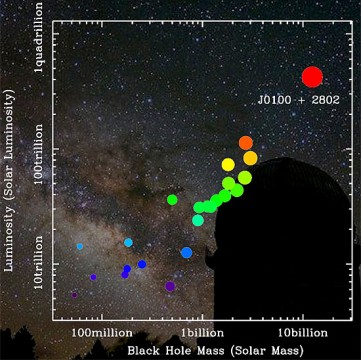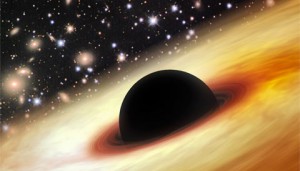A supermassive black hole found only a billion years after the Big Bang adds to growing questions about how such black holes grew so quickly.
Astronomers have discovered one of the brightest quasars in the early universe. The source, SDSS J010013.02+280225.8 (hereafter J0100+2802), is powered by a supermassive black hole at a redshift of 6.3, meaning that its light left it 12.8 billion years ago.

Credit: Data: Zhaoyu Li (Shanghai Astronomical Observatory); Background image: Yunnan Observatories
(Note: due to the universe’s expansion, this does not mean that the quasar is 12.8 billion light-years away, as various press releases have claimed. Because determining the current physical distances to things in the early universe is confusing and inexact, we usually stick with look-back time and redshift, which we can more readily calculate.)
Xue-Bing Wu (Peking University, China) and colleagues found the quasar in an extensive survey of quasars in the early universe that combines visible-light data from the Sloan Digital Sky Survey (SDSS), near-infrared data from the 2-Micron All-Sky Survey (2MASS), and mid-infrared data from the Wide-field Infrared Survey Explorer (WISE). When luminous J0100+2802 stuck out, they attacked it with additional optical and infrared observations, measuring photometry and spectra from several different observatories around the world.
They determined that the quasar puts out energy at about 420 trillion times the rate of the Sun, making it the brightest known quasar beyond a redshift of 6. (Astronomers have detected about 40 quasars this far back in cosmic time.)
The astronomers estimated the black hole’s mass in two ways, first by extrapolating from the quasar’s total luminosity, and then by measuring the speed of clouds that orbit the behemoth. Both methods make assumptions and simplifications but give a mass of 12 or 13 billion solar masses.

Credit: Zhaoyu Li (Shanghai Astronomical Observatory)
As Bram Venemans (Max Planck Institute for Astronomy, Germany) writes in his perspective piece in the February 26th Nature, “It is not implausible to find a black hole of more than 10 billion solar masses within 1 billion years after the Big Bang. But it is still surprising.” To have grown so large so fast, the black hole must have been stuffing itself with gas at close to its maximum accretion rate for most of its existence — which is odd, because the outward push of radiation from the gas being swallowed should have cut off the black hole’s accretion after 10 million to 100 million years.
J0100+2802 is one of a handful of billion-solar-mass black holes seen in the first few hundred million years after the Big Bang. Its existence spurs a lot of questions. How massive is its host galaxy — will it prove to be supermassive, too? How did J0100+2802 grow to be so large so fast? When did it start growing, and from what?
The last question is part of a longstanding debate among black hole astrophysicists. At a press conference at the American Association for the Advancement of Science earlier this month, theorist Priyamvada Natarajan (Yale) said that there’s a real timing problem with growing the first supermassive black holes. If the first supermassive black holes formed from smaller “seed” black holes created when stars went supernova (one of two competing ideas), that leaves only a few hundred million years for black holes the size of J0100+2802 to beef up — a short time span in astrophysics. Instead, discoveries such as J0100+2802 might push more astronomers in favor of the other, “direct-collapse” scenario, where pristine gas collapses on its own into black holes of 1,000 to 10,000 solar masses.*
You can read more about the results in the various press releases put out by the authors’ institutions (there are at least four releases out there, by my count); the most comprehensive are from the Large Binocular Telescope and from the University of Arizona.
References:
X.-B. Wu et al. “An ultraluminous quasar with a twelve-billion-solar-mass black hole at redshift 6.30.” Nature. February 26, 2015.
B. Venemans. “A giant in the young Universe.” Nature. February 26, 2015.
*Update: the original version of this blog connected the question of when the black hole seeds formed with the Planck mission's 2015 results on when galaxies lit up with stars in earnest, but further investigation suggests that Planck's results are superfluous to the discussion — the problem is the same with or without them — so the reference has been removed.
 4
4
Comments
Justin S
February 26, 2015 at 5:27 pm
I wonder if perhaps the big bang was not as smooth as it is typically thought to have been and some of these super massive black holes are primordial.
You must be logged in to post a comment.
Lindsay
February 27, 2015 at 5:23 pm
Utterly amazing! Is it possible for dark matter to form (or collapse into) a black hole?
Did the ratio of dark matter to hydrogen change over time scales of billions of years?
You must be logged in to post a comment.
Peter Wilson
February 28, 2015 at 3:50 pm
Let's say it gained 12 billion solar masses in 600 million years, or 20 solar masses per year (sm/yr). Assume the conversion efficiency is 50%, i.e. 40 sm/yr falls in, but 20 sm/yr of that gets converted into pure energy: the radiation we see.
The 20 sm/yr emitted as pure energy comes out to 0.38 sm/week, or 0.0023 sm/hr, or 1.3E24 kg/s, or 1.1E41 watts. In other words, in order to form in the given amount of time, it must have radiated energy at an average of 1.1E41 watts.
How does its actually luminosity compare to the average luminosity required for it to form using the simplest assumption(s)?
You must be logged in to post a comment.
March 3, 2015 at 3:10 pm
i think black holes are quit amazing,, even tho they are massive and some times scary.
You must be logged in to post a comment.
You must be logged in to post a comment.